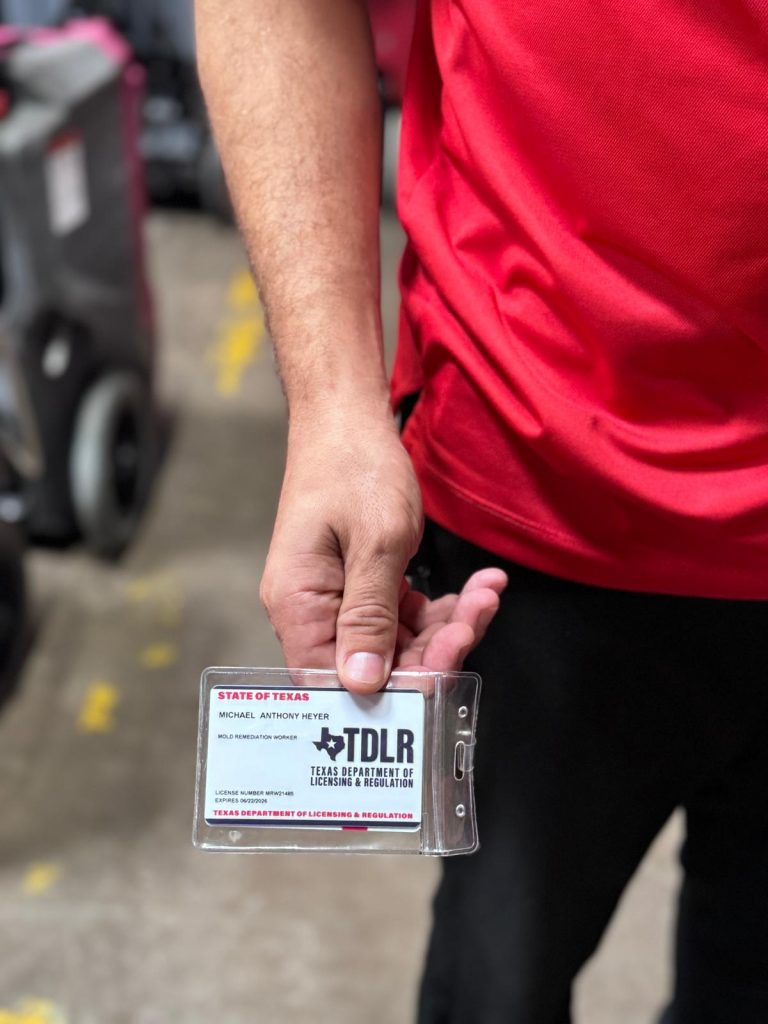Effective water mitigation is the key to preventing further issues when the unexpected happens, and your home faces water damage. I’m Michael Heyer, PuroClean of Central Southwest Houston’s certified Water Mitigation Lead Technician, and I’ve spent over a decade in the field helping homeowners restore their properties. Today, I want to walk you through the water mitigation process, the critical steps we take, and tips for homeowners dealing with water damage.
The First Steps in Water Mitigation
The first thing I do when I arrive at a job is assess the situation. I always start by looking for water and finding out where the moisture is coming from. We track the source of the water and use a moisture meter to figure out how far it has spread through the home. It’s not just about what you can see—the water can seep into walls, floors, and other hidden areas.

Once I know where the water has gone, I look at the building materials affected. If it’s drywall with no insulation behind it, I can often get away with just removing the baseboard and drying out the area. But when you’ve got insulation or glue trapping water or other tricky materials, we need to take a different approach and do some demolition. This prevents mold growth, which is a much bigger problem if left untreated.
Timing is Everything
One of the most important things I’ve learned in water mitigation is that time matters. You need to act quickly to stop a water situation from becoming a mold situation. Ideally, we want to start the drying process within 24 to 48 hours of the damage. That means setting up the right equipment—dehumidifiers, air movers—so the affected areas can dry out as efficiently as possible.

Homeowners often don’t realize that these machines need to run 24 hours a day for three to four days. It’s loud and inconvenient, I understand, but unplugging the equipment only slows the drying process and pushes back the timeline for getting back to normal.
Behind the Scenes of the Process
A big part of my job is explaining what I’m doing and why. When I’m on a water mitigation job, I make sure to walk homeowners through every step of the process. Most people aren’t familiar with the extent of water damage, and it can be overwhelming. I want them to feel comfortable, so I explain what’s happening, why we’re removing certain materials, and how long it’s going to take. I also reassure them that the equipment we use is safe and won’t overload their electrical systems.
If you have pets or kids, it’s good to keep them away from the drying equipment to prevent accidents. I also tape down any cords to minimize the risk of tripping. It’s all about making sure the process is as smooth as possible.

I know it’s not the most exciting part of the process, but documenting everything is essential, especially when working with insurance companies. We take readings of moisture levels daily, take pictures, and document the progress. This isn’t just for us—it’s to show the insurance company that we’re doing everything by the book. It also helps us keep track of which areas are drying faster so we can adjust the equipment if needed. It’s a daily routine to ensure everything is progressing on time.
Understanding Water Mitigation Certifications
You might be wondering why it’s important to have a certified professional handle your water mitigation. I’m certified by the Institute of Inspection Cleaning and Restoration Certification (IICRC), which sets the industry standard for this kind of work. The certification means I’ve been trained in the best practices for dealing with water damage, understanding building materials, and preventing further damage like mold. It’s not just about drying things out—it’s about doing it the right way.

I’ve been in this industry for over 10 years. I started when I was 15, working alongside my father in New York. Since then, I’ve worked in several states, including Florida and Texas, and have handled all kinds of water damage, from everyday leaks to massive storm damage from hurricanes and tornadoes. I’ve chased storms, tackled complex jobs, and learned how to deal with different types of materials and environments.
Final Thoughts for Homeowners
If you’re dealing with water damage, my advice is to act fast and trust the professionals. Water mitigation isn’t something you want to put off. The sooner we can start drying out your home, the better the outcome will be. Yes, the equipment is noisy, and the process can be inconvenient, but it’s all necessary to get your home back to normal as quickly as possible.
If the damage is extensive, you might even want to check with your insurance about temporary accommodation, especially if over half of your home is affected. Living through the noise and disruption can be tough, so don’t hesitate to ask for help if needed.
Experiencing Water Damage? Call the Professionals at PuroClean of Central Southwest Houston
If you’re dealing with water damage, don’t wait—call PuroClean of Central Southwest Houston. Our certified experts, Michael Heyer and the rest of our team, are ready to restore your home and prevent further damage. Reach out today at (832) 856-5900 for fast, reliable service!




 PuroClean of Central Southwest Houston
PuroClean of Central Southwest Houston